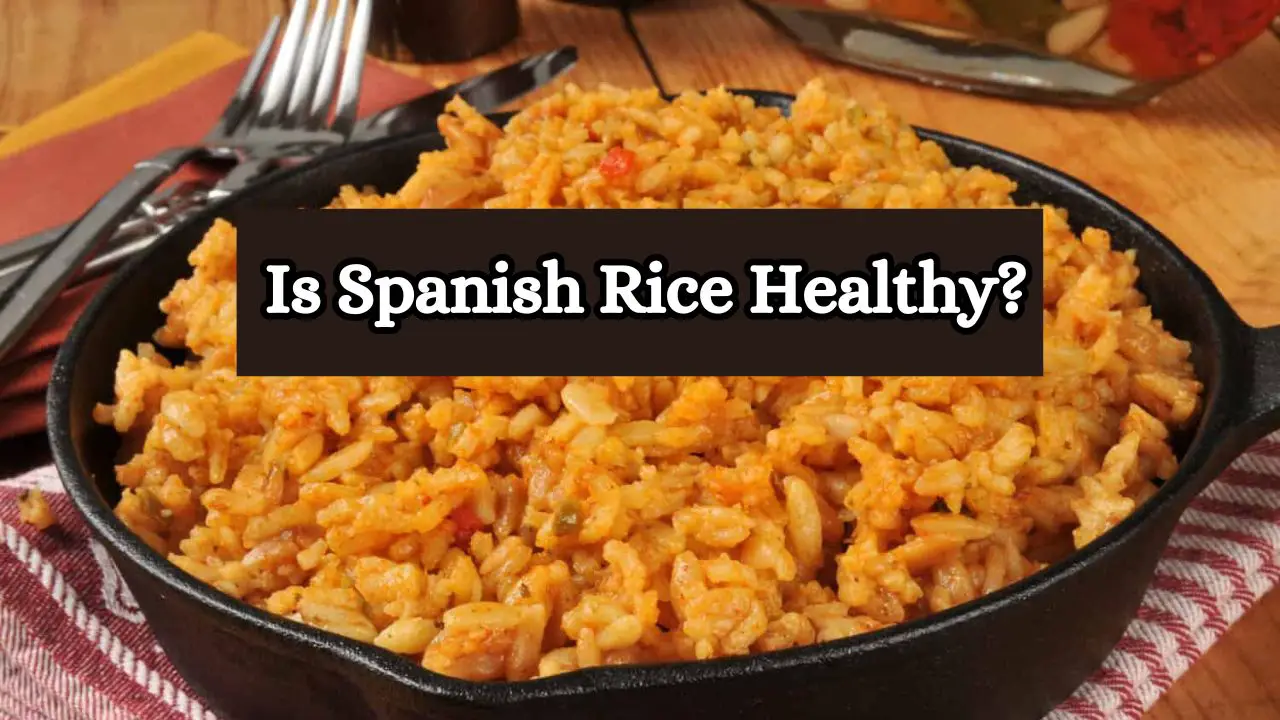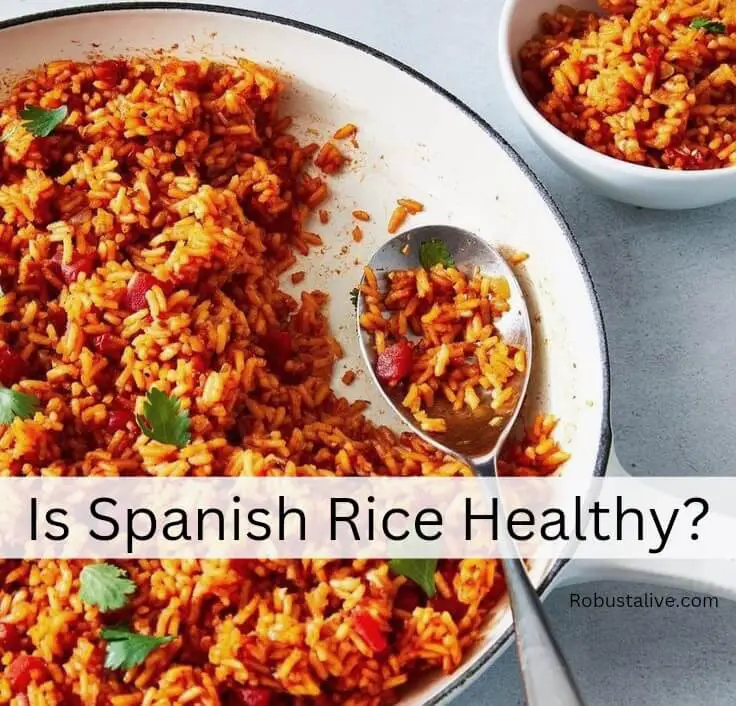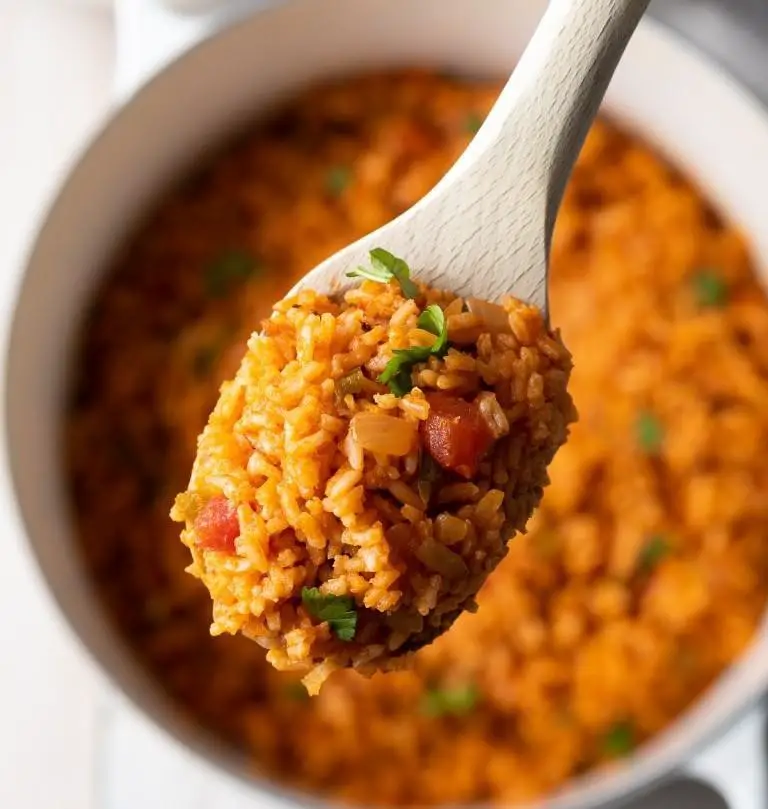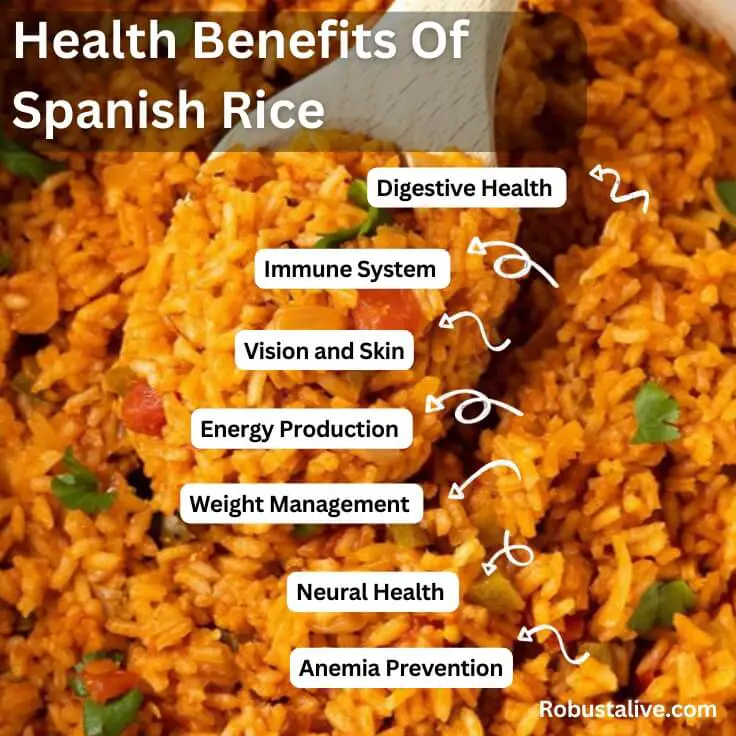Is Spanish Rice Healthy? Find Out the Answers

When it comes to choosing the staples for our daily meals, rice often takes center stage for many people around the world. However, not all types offer the same nutrition.
So, is Spanish rice healthy?
With whole-grain rice, veggies, and lean protein, Spanish rice can be healthy. Watch portion sizes, use healthy cooking methods, and choose herbs and spices over excess salt. It offers fiber, vitamins (C, A, B), minerals (calcium, iron, potassium), aids digestion, supports immunity, and can assist in weight management. For people with diabetes, please don’t eat it too frequently; moderation and whole grains are advised.
This article will uncover whether Spanish rice can be a part of a balanced and healthy diet.
What Is Spanish Rice?
Spanish rice, also known as “paella,” originates from the rice-growing regions of Spain’s Mediterranean coast, particularly Valencia. It is a flavorful and aromatic dish that features rice cooked as a Spanish pilaf.
The dish is seasoned with ingredients like saffron, bell peppers, onions, and garlic. These seasonings give Spanish rice its distinctive sweet-savory flavor and vibrant golden hue.
Depending on regional variations and personal preferences, additional ingredients such as vegetables, seafood, or meat can be added to the recipe.

Is Spanish Rice Healthy?
Spanish rice is healthy; this dish offers a delicious taste and is a nutritious choice since it combines vegetables and rice to provide essential vitamins and minerals while being relatively low in fat and calories.
Just ensure you prepare it with the right ingredients and eat it in moderation. Here’s what you should keep in mind:
- Ingredients: What goes into your Spanish rice matters a lot. It can be a nutritious dish if you use whole-grain rice, lots of veggies, lean proteins, and don’t go overboard with fats.
- Cooking methods: How you cook the rice makes a difference, too. Using too much oil or butter can add extra calories and unhealthy fats. Opt for healthier methods like using a bit of olive oil or baking instead of frying.
- Portion control: Like with any meal, be mindful of how much you eat. Even healthy Spanish rice can become a problem if you have too much of it and consume too many calories.
- Nutrients: Spanish rice can offer valuable nutrients like fiber from whole grains, vitamins and minerals from veggies, and protein from ingredients like beans or lean meats.
- Seasonings and spices: The flavors you add also affect how healthy it is. Use herbs and spices for taste instead of piling on salt, which can be unhealthy in large quantities.
How Many Calories Are In Spanish Rice?
The calorie count in Spanish rice can fluctuate based on the specific recipe and portion size. Generally, a one-cup serving of homemade Spanish rice tends to have approximately 200-250 calories.
Nevertheless, this can differ, influenced by the ingredients and cooking techniques. To get a more precise calorie breakdown, it’s advisable to refer to the packaging or the specific recipe you’re using.
Spanish Rice Nutritional Profile
Here’s a table showing the nutrition facts for one cup (116 grams) of Spanish rice:
| Nutrient | Amount Per Serving |
| Calories | 215 |
| Total Fat | 6.1 grams |
| Cholesterol | 0 mg |
| Sodium | 612 mg |
| Total Carbohydrates | 36 grams |
| Dietary Fiber | 1.4 grams |
| Sugars | 1.5 grams |
| Protein | 3.8 grams |
| Calcium | 23 mg |
| Iron | 1.3 mg |
| Potassium | 134.6 mg |
Health Benefits Of Spanish Rice
Let’s delve even deeper into the detailed health benefits of Spanish rice:
Fiber for Digestive Health
Spanish rice is an excellent source of dietary fiber, with one serving to provide about 1.4 grams of fiber. Fiber plays a crucial role in promoting healthy digestion. It adds bulk to stool, preventing constipation, and supports regular bowel movements. A fiber-rich diet can also lower the risk of digestive issues like diverticulitis.
Vitamin C for Immune Support
Spanish rice contains vitamin C, primarily derived from ingredients like green chilies and tomato sauces. Approximately 26.7 milligrams per serving offers significant immune support by helping your body fight off infections and illnesses.
Vitamin A for Vision And Skin
Spanish rice also provides ample amounts of vitamin A, crucial for maintaining healthy vision and skin. This vital vitamin contributes to clear eyesight and supports the growth and repair of skin tissues.
B Vitamins for Energy Production
Spanish rice’s nutritional elements encompass essential B vitamins such as thiamin, niacin, and folate. These B vitamins are key players in energy production. They assist in converting the food you eat into usable energy, vital for daily activities and vitality.
Mineral Trio for Body Function
Spanish rice is a nutritious dish that contains essential minerals such as calcium, iron, and potassium. A single serving provides approximately 28.5 milligrams of calcium, crucial for maintaining strong bones, and 239.3 milligrams of potassium, which contributes to healthy heart and muscle function.
Additionally, Spanish rice supports the production of red blood cells due to its iron content.
Weight Management And Satiety
If you’re watching your weight, Spanish rice can be a valuable addition to your diet. It’s naturally low in fat and cholesterol-free. Furthermore, its fiber content promotes a feeling of fullness and can help control appetite, making it a suitable choice for those looking to manage their weight.
Sustainable Energy
Spanish rice is a great supply of carbohydrates, your body’s primary energy source. It provides a steady and sustained release of energy, making it an ideal choice for individuals needing nutrition and flavor to fuel their daily activities.
Choline For Neural Health
Choline, found in Spanish rice, is essential for neural health. It supports cell structure and communication between neurons. Adequate choline intake can contribute to improved cognitive function and overall neural health.
Anemia Prevention
The iron content in Spanish rice aids in producing red blood cells. Adequate iron levels are essential for preventing anemia, a condition characterized by fatigue and weakness due to insufficient oxygen-carrying capacity in the blood.
Immune System Fortification
They are packed with essential nutrients like vitamin C, vitamin A, and various minerals; Spanish rice bolsters your body’s defenses. These powerful elements empower white blood cells to efficiently battle diseases and infections.
Is Spanish Rice Good For Diabetes?
Spanish rice can be a part of the diet for individuals managing diabetes, but it should be enjoyed in moderation. Also, please don’t eat it too frequently.
It is crucial to practice portion control and opt for whole grain alternatives like whole grain Basmati rice.
These options have a lower glycemic index, which helps stabilize blood sugar levels. Maintaining a balanced diet and monitoring carbohydrate intake are essential to effectively managing diabetes.
Is Spanish Rice Good For Weight Loss?
Spanish rice can be a part of a balanced diet when you’re aiming for weight loss, much like many other foods. The key lies in moderation – controlling your portion sizes and selecting healthy ingredients.
Opting for brown rice instead of white rice can be wise as it provides added fiber and essential nutrients. Also, be mindful of the quantity of oil and high-calorie toppings you use during preparation.
To make Spanish rice a nutritious and satisfying part of your weight loss journey, consider pairing it with lean protein sources and incorporating plenty of vegetables into your meal. It can create a well-rounded, wholesome dish supporting weight loss goals.
Keep in mind that maintaining an overall calorie balance and following a diverse and balanced diet remain fundamental principles for achieving successful weight loss.
Is Spanish Rice The Same As Mexican Rice?
Spanish rice and Mexican rice are not the same.
- Spanish rice is firmer with a stronger aroma, often cooked in saffron for a delicate, semi-sweet flavor and vibrant yellow color. It doesn’t turn mushy quickly and is suitable for sweet and savory dishes.
- Mexican rice, on the other hand, is soft, fluffy, and usually red-orange in color due to cumin. It has a nutty and spicy taste and is not clumpy or sticky.
They have distinct characteristics and flavors, making them different types of rice.

Easy And Healthy Spanish Rice Recipe
Here’s a simple and healthy Spanish rice recipe:
Ingredients:
– 1 cup brown rice
– 1 medium onion, finely chopped
– 1 red bell pepper, diced
– 1 green bell pepper, diced
– 2 cloves garlic, minced
– 1 can (14 ounces) diced tomatoes
– 1 1/2 cups vegetable broth
– 1 teaspoon ground cumin
– 1 teaspoon chili powder
– 1/2 teaspoon paprika
– Salt and pepper to taste
– 2 tablespoons olive oil
– Fresh cilantro for garnish (optional)
Instructions
Step 1: In a large pan, heat some olive oil over medium heat. Add the chopped onions and garlic, cooking until they become clear.
Step 2: Put in the diced bell peppers and continue cooking until they soften.
Step 3: Add the brown rice and cumin, chili powder, paprika, salt, and pepper. Toast them by cooking for about 2-3 minutes.
Step 4: Pour in the diced tomatoes and vegetable broth and thoroughly mix everything.
Step 5: Allow it to boil before reducing the heat and covering the pan. Let it simmer for approximately 45 minutes or until the rice becomes soft and absorbs all the liquid. Stir occasionally to prevent sticking.
Step 6: Take the pan off the heat and let it sit, covered, for 5 minutes.
Step 7: Use a fork to fluff the Spanish rice and add fresh cilantro for extra flavor if you like.
Enjoy your healthy homemade Spanish rice! You can customize it by adding cooked vegetables, beans, or lean protein for a well-rounded meal.
Frequently Asked Questions (FAQs)
Is Spanish Rice Fattening?
Spanish rice can be fattening if prepared with excessive oil or high-calorie ingredients, or it can be transformed into a healthier option by reducing the oil and emphasizing the inclusion of nutritious vegetables. The overall calorie content varies based on its preparation techniques.
Is Spanish Rice Gluten-free?
Yes, Spanish rice made with essential ingredients like rice, tomatoes, and spices is gluten-free. However, some packaged or restaurant versions may have gluten, so be careful. Homemade Spanish rice without gluten ingredients is a safe choice.
Is Spanish Rice Vegan?
Spanish rice can be vegan if it’s made without any animal products like meat, dairy, or broth, using vegetable ingredients instead.
Is Spanish Rice White Or Brown?
Spanish rice can be prepared using either white or brown rice. The decision typically hinges on individual taste preferences and dietary requirements. Traditional Spanish rice recipes usually feature white rice, while brown rice can impart a nuttier flavor and offer added nutritional advantages.
Conclusion
To conclude, Spanish rice can be a healthy addition to your diet when prepared thoughtfully with its rich flavors and nutritional benefits. It offers fiber, vitamins, minerals, and sustainable energy. Whether you’re managing diabetes or aiming for weight loss, portion control and ingredient choices matter.
Try a homemade, healthy recipe to savor this delicious dish while promoting your well-being.






